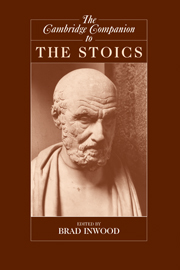Book contents
- Frontmatter
- Introduction
- 1 The School, from Zeno to Arius Didymus
- 2 The School in the Roman Imperial Period
- 3 Stoic Epistemology
- 4 Logic
- 5 Stoic Natural Philosophy (Physics and Cosmology)
- 6 Stoic Theology
- 7 Stoic Determinism
- 8 Stoic Metaphysics
- 9 Stoic Ethics
- 10 Stoic Moral Psychology
- 11 Stoicism and Medicine
- 12 The Stoic Contribution to Traditional Grammar
- 13 The Stoics and the Astronomical Sciences
- 14 Stoic Naturalism and Its Critics
- 15 Stoicism in the Philosophical Tradition
- Bibliography
- List of Primary Works
- Index
13 - The Stoics and the Astronomical Sciences
Published online by Cambridge University Press: 28 May 2006
- Frontmatter
- Introduction
- 1 The School, from Zeno to Arius Didymus
- 2 The School in the Roman Imperial Period
- 3 Stoic Epistemology
- 4 Logic
- 5 Stoic Natural Philosophy (Physics and Cosmology)
- 6 Stoic Theology
- 7 Stoic Determinism
- 8 Stoic Metaphysics
- 9 Stoic Ethics
- 10 Stoic Moral Psychology
- 11 Stoicism and Medicine
- 12 The Stoic Contribution to Traditional Grammar
- 13 The Stoics and the Astronomical Sciences
- 14 Stoic Naturalism and Its Critics
- 15 Stoicism in the Philosophical Tradition
- Bibliography
- List of Primary Works
- Index
Summary
In Stoicism, as in Epicureanism, an understanding of the physical place of humanity in the universe was an integral component of a system of thought underpinning each sect's ethical commitments. At the same time as these schools flourished, non-philosophical disciplines were evolving that laid claim to knowledge of parts of this subject: astronomy, which concerned the composition and regularity of the heavens in their own right; geography, which investigated the form and characteristics of the earth and its inhabited parts; and astrology, which asserted connections between the celestial motions and mundane life. The fundamental assumptions of these scientific disciplines were from the start so completely at odds with Epicurus' atomistic, aleatory cosmology that Epicureanism and the exact sciences were doomed to a relationship of mutual irrelevance so long as they coexisted. Between Stoicism and the sciences the possibilities of interaction were greater; though, as we shall see, there were limits to their readiness to embrace each other's approaches.
ASTRONOMY
The central matter of astronomia as it was commonly understood up to the Hellenistic period was the organization of the stars into their constellations and the association of their annual cycle of risings and settings with patterns of weather and human (mostly agricultural) activity.1 But Eudoxus’ astronomical works, which are known to us only through excerpts and secondhand reports, exemplified and indeed likely pioneered a considerable expansion of the science’s scope: in addition to the traditional topics of constellations, weather patterns, and calendrical cycles, he investigated conceptual geometrical models that sought to account for the phenomena of the heavenly bodies and that could be interpreted as reflecting the physical nature of the cosmos.
- Type
- Chapter
- Information
- The Cambridge Companion to the Stoics , pp. 328 - 344Publisher: Cambridge University PressPrint publication year: 2003
- 8
- Cited by



